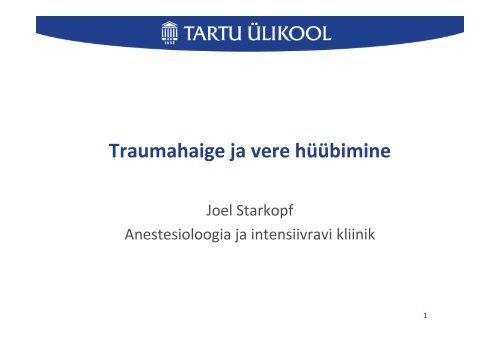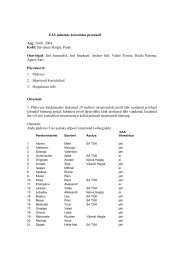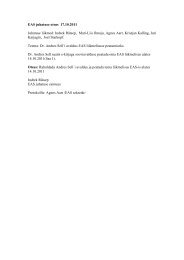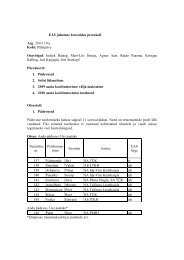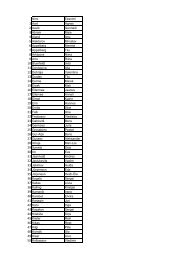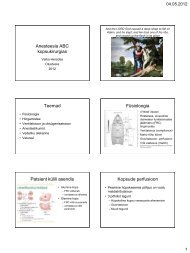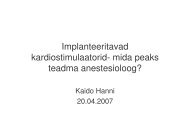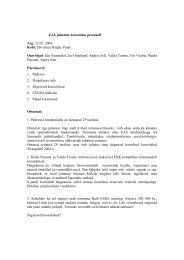Traumahaige ja hüübimine
Traumahaige ja hüübimine
Traumahaige ja hüübimine
You also want an ePaper? Increase the reach of your titles
YUMPU automatically turns print PDFs into web optimized ePapers that Google loves.
<strong>Traumahaige</strong> <strong>ja</strong> vere hüübimine<br />
Joel Starkopf<br />
Anestesioloogia <strong>ja</strong> intensiivravi kliinik<br />
1
• Äge koagulopaatia trauma puhul<br />
• Diagnoosikriteeriumid<br />
• Tromboelastograafia<br />
• Damage control resuscitation<br />
– Lubatav hüpotensioon<br />
– Soojendamine<br />
– Atsideemia<br />
– S-Ca korrektsioon<br />
• Verepreparaadid<br />
• Hüübimisfaktorid<br />
• Hüübimist mõjutavad ravimid<br />
2
• PubMed “trauma and coagulation” al. 2000…2009<br />
• As Germany is the only country where the use of blood products is regulated<br />
by a special transfusion law requiring the publication of cross-sectional<br />
guidelines, the German Medical Association’s 4 th revised edition of the Crosssectional<br />
Guidelines for Therapy with Blood Components and Plasma<br />
Derivatives[2] was an additional focus of the article.<br />
• Shakur H, Roberts I, Bautista R, et al (2010) Effects of tranexamic acid on<br />
death, vascular occlusive events, and blood transfusion in trauma patients<br />
with significant haemorrhage (CRASH-2): a randomised, placebo-controlled<br />
trial. Lancet 376:23–32<br />
• Rossaint R, Bouillon B, Cerny V, et al (2010) Management of bleeding<br />
following major trauma: an updated European guideline. Crit Care 14:R52<br />
• Kokku 230 artiklit<br />
3
• On the basis of the 2001 classification published by the Oxford Centre<br />
of Evidence Based Medicine (CEBM, www.cebm.net ), an evaluation<br />
of the level of evidence (LoE) of the cited articles was consensually<br />
made by the authors. Almost half of these articles were downgraded<br />
as they were contextually not totally accurate. To evaluate the LoE of<br />
our core findings, the CEBM classification system using grade A (LoE<br />
1), B (LoE 2–3) or 0 (LoE 4–5) was chosen.<br />
• Like the Cross-sectional Guidelines for Therapy with Blood<br />
Components and Plasma Derivatives, our recommendations are<br />
mostly based on case observations and non-randomized trials. Hence,<br />
only a grade of recommendation (GoR) ‘‘0’’ can be given for many.<br />
4
Järgnevad soovitused käivad ainult<br />
patsientide kohta, kellel esineb<br />
massiivne, eluohtlik verekaotus.<br />
5
Äge koagulopaatia trauma puhul<br />
• Sekundaarne – dilutsioon, hüpotermia, atsidoos,<br />
hüpokaltseemia<br />
• Primaarne, iseseisev sündroom<br />
• Hüperfibrinolüüs! Korreleerub trauma raskusega<br />
• ~ 30 % raske trauma haigetest esineb äge koagulopaatia<br />
EMO-sse saabumisel<br />
• Mehhanism<br />
6
Äge koagulopaatia trauma puhul<br />
7
Endoteeli kahjustus<br />
+ hüpoperfusioon<br />
Trombiin<br />
TM<br />
Trombiin/<br />
trombomoduliin<br />
kompleks<br />
Maksa<br />
hüpoperfusioon<br />
aPC<br />
PS<br />
↓ FVa<br />
↓ FVIIIa<br />
↓ PAI - 1<br />
↑ t-PA<br />
Brohi K, et al. (2003) J Trauma 54:1127–1130<br />
Hüperfibrinolüüs<br />
8
Äge koagulopaatia trauma puhul<br />
• Sekundaarne – dilutsioon, hüpotermia, atsidoos,<br />
hüpokaltseemia<br />
• Primaarne, iseseisev sündroom<br />
• Hüperfibrinolüüs! Korreleerub trauma raskusega<br />
• ~ 30 % raske trauma haigetest esineb äge koagulopaatia<br />
EMO-sse saabumisel<br />
• Mehhanism<br />
⇒ Trauma koagulopaatia on eraldiseisev sündroom, mis<br />
oluliselt mõjutab elulemust. Diagnostika <strong>ja</strong> ravi peavad<br />
algama kohe EMO-s (GoR A).<br />
9
Diagnoosikriteeriumid<br />
• Kliiniline pilt. Punktsioonikohad, difuusne veritsus..<br />
• aPTT, PT, trombotsüütide arv – peegeldavad halvasti<br />
veritsuse võimalikkust<br />
• Hüpotermia, laktaat <strong>ja</strong> BE, hüpokaltseemia, hüpotermia<br />
⇒ “Klassikalised” hüübimisparameetrid (APTT, PT, PLT) on<br />
ebapiisavad diagnoosimiseks, aga pole ka paremaid<br />
parameetreid. (GoR 0)<br />
⇒ Kliiniline pilt<br />
10
Tromboelastograafia/-meetria<br />
• TEG/ROTEM<br />
• Raske trauma haige vastuvõtul või enne operatsiooni algväärtuste<br />
fikseerimiseks kõrge veritsusriskiga patsiendil<br />
• Kestva, kirurgiliselt mittekorrigeeritava veritsuse korral<br />
• Pärast iga veremahu asendamist<br />
• Pärast hüübimist soodustavate ravimite kasutamist<br />
• Postoperatiivselt hüperkoagulatsiooni kindlakstegemiseks<br />
Kozek-Langenecker S (2007) Monitoring hemostasis in emergency medicine. In: Vincent JL<br />
(ed) Yearbook of intensive care emergency medicine 2007, vol XXXII, Springer, Berlin, pp<br />
847–859<br />
11
ERROR: undefined<br />
OFFENDING COMMAND: f‘~<br />
STACK:


